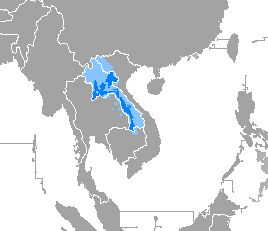
Lao, sometimes referred to as Laotian, is the official language of Laos and a significant language in the Isan region of northeastern Thailand, where it is usually referred to as the Isan language. Spoken by over 3 million people in Laos and 3.7 million in all countries, it serves as a vital link in the cultural and social fabric of these areas. It is written in the Lao script, an abugida that evolved from ancient Tai scripts.
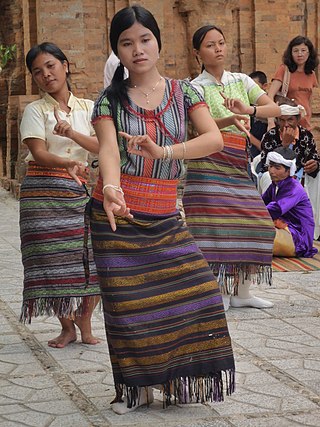
The Chams, or Champa people, are an Austronesian ethnic group in Southeast Asia and are the original inhabitants of central Vietnam and coastal Cambodia before the arrival of the Cambodians and Vietnamese, during the expansion of the Khmer Empire and the Vietnamese conquest of Champa.
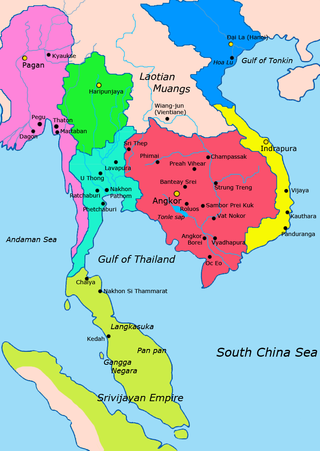
Champa was a collection of independent Cham polities that extended across the coast of what is present-day central and southern Vietnam from approximately the 2nd century CE until 1832. According to earliest historical references found in ancient sources, the first Cham polities were established around the 2nd to 3rd centuries CE, in the wake of Khu Liên's rebellion against the rule of China's Eastern Han dynasty, and lasted until when the final remaining principality of Champa was annexed by Emperor Minh Mạng of the Vietnamese Nguyễn dynasty as part of the expansionist Nam tiến policy. The kingdom was known variously as Nagaracampa, Champa (ꨌꩌꨛꨩ) in modern Cham, and Châmpa (ចាម្ប៉ា) in the Khmer inscriptions, Chiêm Thành in Vietnamese, Campa in Malay, Zhànchéng in Chinese records, and al-Ṣanf in Middle Eastern Muslim records.

Hinduism in Southeast Asia had a profound impact on the region's cultural development and its history. As the Indic scripts were introduced from the Indian subcontinent, people of Southeast Asia entered the historical period by producing their earliest inscriptions around the 1st to 5th century CE. Today, Hindus in Southeast Asia are mainly Overseas Indians and Balinese. There are also Javanese and Balamon Cham minority in Cambodia and south central Vietnam who also practice Hinduism.
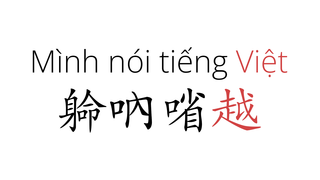
Spoken and written Vietnamese today uses the Latin script-based Vietnamese alphabet to represent native Vietnamese words, Vietnamese words which are of Chinese origin, and other foreign loanwords. Historically, Vietnamese literature was written by scholars using a combination of Chinese characters (Hán) and original Vietnamese characters (Nôm). From 111 BC up to the 20th century, Vietnamese literature was written in Văn ngôn using chữ Hán, and then also Nôm from the 13th century to 20th century.

Mỹ Sơn is a cluster of abandoned and partially ruined Shaiva Hindu temples in central Vietnam, constructed between the 4th and the 13th century by the Kings of Champa, an Indianized kingdom of the Cham people. The temples are dedicated to the veneration of God in accordance with Shaivism, wherein God is named Shiva, or The Auspicious One. In this particular complex, he is venerated under various local names, the most important of which is Bhadreshvara.

The Cham script is a Brahmic abugida used to write Cham, an Austronesian language spoken by some 245,000 Chams in Vietnam and Cambodia. It is written horizontally left to right, just like other Brahmic abugidas.

The culture of Vietnam are the customs and traditions of the Kinh people and the other ethnic groups of Vietnam. Vietnam is part of Southeast Asia and the Sinosphere due to the influence of Chinese culture on Vietnamese culture.

Greater India, also known as the Indian cultural sphere, or the Indic world, is an area composed of several countries and regions in South Asia, East Asia and Southeast Asia that were historically influenced by Indian culture, which itself formed from the various distinct indigenous cultures of South Asia. It is an umbrella term encompassing the Indian subcontinent and surrounding countries, which are culturally linked through a diverse cultural cline. These countries have been transformed to varying degrees by the acceptance and introduction of cultural and institutional elements from each other. The term Greater India as a reference to the Indian cultural sphere was popularised by a network of Bengali scholars in the 1920s, but became obsolete in the 1970s.
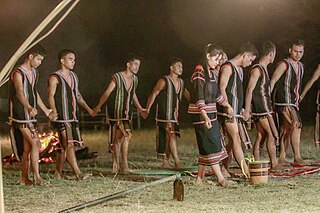
Jarai people or Dega are an Austronesian indigenous people and ethnic group native to Vietnam's Central Highlands, as well as in the Cambodian northeast Province of Ratanakiri. During the Vietnam War, many Jarai persons, as well as members of other Montagnard groups, collaborated with US Special Forces, and many were resettled with their families in the United States, particularly in North Carolina, after the war.

Cham is a Malayo-Polynesian language of the Austronesian family, spoken by the Chams of Southeast Asia. It is spoken primarily in the territory of the former Kingdom of Champa, which spanned modern Southern Vietnam, as well as in Cambodia by a significant population which descends from refugees that fled during the decline and fall of Champa. The Western variety is spoken by 220,000 people in Cambodia and 25,000 people in Vietnam. As for the Eastern variety, there are about 73,000 speakers in Vietnam, for a total of approximately 490,000 speakers.

While the practice of Islam in Vietnam is primarily associated with the Cham people, an Austronesian minority ethnic group, roughly one-third of Muslims in Vietnam are of other ethnic groups. There is also a community which describes itself as of mixed ethnic origins, that practices Islam and also describes themselves as the Cham, or Cham Muslims, around the region of Châu Đốc.

The largest of the ethnic groups in Cambodia are the Khmer, who comprise 95.8% of the total population and primarily inhabit the lowland Mekong subregion and the central plains. The Khmer historically have lived near the lower Mekong River in a contiguous arc that runs from the southern Khorat Plateau where modern-day Thailand, Laos and Cambodia meet in the northeast, stretching southwest through the lands surrounding Tonle Sap lake to the Cardamom Mountains, then continues back southeast to the mouth of the Mekong River in southeastern Vietnam.
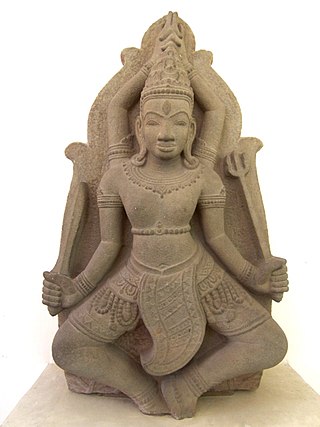
Champa was an Southeast Asian civilization that flourished along the coasts of what is now central and southern Vietnam for roughly a one thousand-year period between 500 and 1700 AD. The original Cham and Proto-Chamic peoples were mainland Austronesian sailors, who adopted as their principal vocations those of trade, shipping, and piracy. Their cities were ports of call on important trade routes linking India, China and the Indonesian islands. The history of Champa was one of intermittent conflict and cooperation with the people of Java, the Khmer of Angkor in Cambodia and Đại Việt (Annam) of the Vietnamese in what is now northern Vietnam. It was to Dai Viet that Champa finally lost its independence.
The history of Champa begins in prehistory with the migration of the ancestors of the Cham people to mainland Southeast Asia and the founding of their Indianized maritime kingdom based in what is now central Vietnam in the early centuries AD, and ends when the final vestiges of the kingdom were annexed and absorbed by Vietnam in 1832.
The Đông Yên Châu inscription is an Old Cham inscription written in Pallava script, found in 1936 at Đông Yên Châu, northwest of Trà Kiệu, which used to be the old Champa capital known as Simhapura, in central Vietnam. The inscription was written in prose, is the oldest document of Cham, and testifies to the existence of indigenous beliefs among the ancient Cham people of the Champa kingdom. Though not itself dated, the phrasing of the inscription is identical to those of dated Sanskrit inscriptions of Bhadravarman I of the second dynasty, who ruled Champa at the end of the 4th century CE. It contains an imprecatory formula ordering respect for the "naga of the king", undoubtedly a reference to the protective divinity of a spring or well. This vernacular text shows that in the 4th century, the land that now constitutes modern-day central Vietnam was inhabited by an Austronesian-speaking population. The evidence, both monumental and palaeographic, also suggests that Hinduism was the predominant religious system.
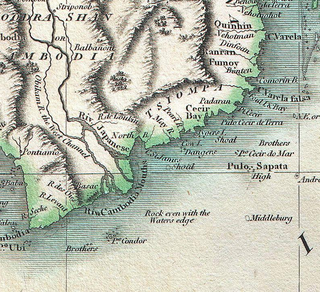
Panduranga or Prangdarang was a Cham Principality. Panduranga was the rump state of the Champa kingdom after Lê Thánh Tông, emperor of Đại Việt, destroyed Champa in 1471 as part of the general policy of Nam tiến. The Panduranga principality was located in present-day south-central Vietnam and its centre is around the modern day city of Phan Rang. It stood until late 17th century when the Nguyễn lords of Đàng Trong, a powerful Vietnamese clan, vassalized it and subjugated the Cham polity as the Principality of Thuận Thành.

Xitu was the Chinese designation for a historical region or a Chamic polity or kingdom that was first mentioned in the mid of fifth century AD, is believed to be one of the predecessors of Champa Kingdom. It has been proposed to be located in the Thu Bồn River Valley, present-day Quảng Nam Province, Central Vietnam.

Principality of Thuận Thành, commonly known to the Cham as Pänduranga or Prangdarang, neologism Panduranga Champa, was the last Cham state that centered around the modern day city of Phan Rang in south-central Vietnam. Both Thuận Thành of Vietnamese perspectives and Panduranga were mutually used to refer to the last Cham polity. The decline and fading of Champa did not happen in a short period. Instead, for a long period from the late 17th century to 1832, Panduranga had been confined as an ad hoc client state of various Vietnamese dominions, but still maintained its faint independence. After a Cham revolt in 1692–94 and pressures from Cham king Po Saktiraydapatih, Southern Vietnamese lord Nguyễn Phúc Chu abolished his annexation of Panduranga and revived the Champa kingdom under the byname of Trấn Thuận Thành or the Principality of Thuận Thành, effectively made it a client state of the Nguyễn domain throughout the 18th century. Constant upheavals, social unrest, and the Tay Son rebellion in Dai Viet overthrew the ruling Nguyen and Trinh domains and Le dynasty during the late 18th century, and as long civil wars between Vietnamese factions raged, the principality of Thuận Thành continued to survive until summer 1832 when Vietnamese emperor Minh Mang annexed and incorporated the kingdom of Thuận Thành into his territory, decisively marking the final demise of the millennial Champa Kingdoms.
















